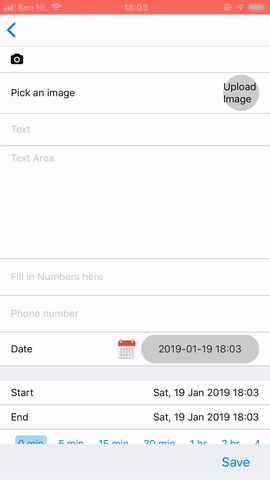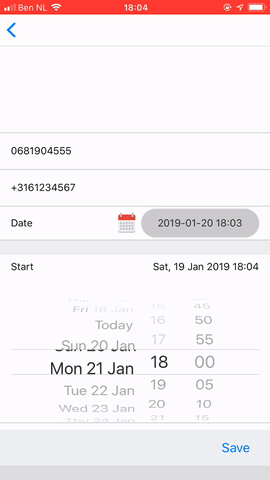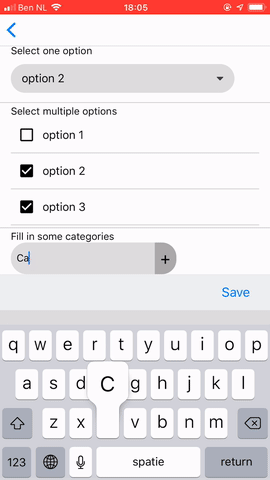react-native-data-forms v2.1.4
React Native Data Forms
Create beautiful forms that submit data to redux, a graphql mutation, or an api in many different input types
React-native-data-forms is an opinionated yet very flexible library that makes data from any source editable using react native components. The data can be of many different types. If you have an app with many data properties that need to be edited, this can be a huge boilerplate reducer! For me it was, at least. When I introduced it it instantly removed >1000 LOC in my codebase. Then, I doubled the amount of pages with only a few dozen LOC added. Without this component that would be thousands of LOC.
This component is built for mutations of React Apollo GraphQL, but it can potentially also be used together with local databases, redux, or even state!
The goal of this function is to seperate semantics from data from implementation of showing editable and savable database data from any mutation, where data can have any type.
Documentation
Setup
Step 1:
- Install the library:
yarn add react-native-data-forms - Install the input types library if you wish to use ours:
yarn add leckr-inputs
Step 2:
Create a wrapper of our component:
If you want to use our data-types:
import React from "react";
import expo from "expo";
import { inputs, FieldComponent } from "leckr-inputs";
import _DataForm from "react-native-data-forms";
//optionally, import your own inputs
import emailsOrUsers from "../fat/emailsOrUsersInput";
//this is needed for image upload
const firebaseConfig = {
apiKey: "?",
authDomain: "?",
databaseURL: "?",
projectId: "?",
storageBucket: "?",
messagingSenderId: "?"
};
//this is needed for the location type
const googlePlacesConfig = {
key: "?"
};
const DataForm = props => {
//initialize our input types with the props they need
const leckrInputs = inputs({
firebaseConfig,
googlePlacesConfig,
expo,
navigation: props.navigation
});
const inputTypes = {
...leckrInputs,
//add your own custom types
emailsOrUsers
};
const allProps = {
...props,
inputTypes,
FieldComponent
};
return <_DataForm {...allProps} />;
};
export default DataForm;If you will import your own data-types and don't use ours:
import React from "react";
//import your own inputs and fieldcomponent.
import { inputs, FieldComponent } from "????";
import _DataForm from "react-native-data-forms";
const DataForm = props => {
const allProps = {
...props,
inputTypes: inputs,
FieldComponent
};
return <_DataForm {...allProps} />;
};
export default DataForm;Step 3:
If you need the location or image type from leckr-inputs, you need to add the leckr-inputs screens to your navigation stack where you want the image-screen and location-screen to load, like so:
react-navigation:
import { screens } from "leckr-inputs";
const Stack = createStackNavigator({
root: { screen: HomeScreen },
...screens
});wix/react-native-navigation:
import { Navigation } from "react-native-navigation";
import { screens } from "leckr-inputs";
Object.keys(screens).forEach(key => {
const { screen, navigationOptions } = screens[key];
if (navigationOptions && navigationOptions.header) {
// make sure not to render a header for this wix nav
}
const route = key;
const props = {};
Navigation.registerComponent(route, () => screen, ...props);
});Example
You're all set up! You can use the component like this: This is an example with all default types, getting data from a GraphQL query, sending it to a GraphQL mutation:
import React from "react";
import gql from "graphql-tag";
import { compose, graphql } from "react-apollo";
import { DataForm } from "../import";
import { Field } from "react-native-data-forms/types";
import { Alert } from "react-native";
class Example extends React.Component {
render() {
const { data, mutate, navigation } = this.props;
const defaultComplete = () => Alert.alert("Saved");
const fields: Field[] = [
{ field: "coverImage", type: "coverImage" },
{ field: "image", type: "image", title: "Pick an image" },
{ field: "text", title: "Text" }, //default type is a text input
{ field: "textArea", title: "Text Area", type: "textArea" },
{ field: "numbers", title: "Fill in Numbers here", type: "numbers" },
{ field: "phone", title: "Phone number", type: "phone" },
{ field: "date", title: "Date", type: "date" },
{
field: "STARTEND",
titles: {
start: "Start",
end: "End"
},
mapFieldsToDB: ({ start, end }) => ({
eventAt: start,
eventEndAt: end
}),
startSection: true,
type: "dates"
},
{
startSection: true,
field: "color",
title: "Color",
type: "color"
},
{ field: "boolean", title: "Boolean type", type: "boolean" },
{
startSection: true,
field: "LOCATION",
mapFieldsToDB: same => same, //but different
title: "Location",
type: "location"
},
{
field: "selectOne",
title: "Select one option",
type: "selectOne",
values: [
{ value: 1, label: "option 1" },
{ value: 2, label: "option 2" },
{ value: 3, label: "option 3" }
]
},
{
field: "selectMultiple",
title: "Select multiple options",
type: "selectMultiple",
values: ["option 1 ", "option 2 ", "option 3"]
},
{
field: "categories",
title: "Fill in some categories",
type: "categories"
},
{ field: "dictionary", title: "Dictionary", type: "dictionary" }
];
return (
<DataForm
navigation={navigation}
fields={fields}
onComplete={defaultComplete}
mutate={vars => mutate(vars)}
values={data.example}
/>
);
}
}
const query = gql`
query Example {
example {
coverImage
image
text
textArea
numbers
phone
date
color
boolean
selectOne
selectMultiple
categories
dictionary
eventAt
}
}
`;
const mutation = gql`
mutation ExampleMutation(
$coverImage: String
$image: String
$text: String
$textArea: String
$numbers: Int
$phone: String
$date: Date
$color: String
$boolean: Boolean
$selectOne: String
$selectMultiple: String
$categories: String
$dictionary: String
$eventAt: Date
) {
exampleMutation(
coverImage: $coverImage
image: $image
text: $text
textArea: $textArea
numbers: $numbers
phone: $phone
date: $date
color: $color
boolean: $boolean
selectOne: $selectOne
selectMultiple: $selectMultiple
categories: $categories
dictionary: $dictionary
eventAt: $eventAt
)
}
`;
export default compose(
graphql(query),
graphql(mutation)
)(Example);This will look like this:



Props
Expanding
In the future, I'm planning to add these features to the codebase.
- Single Sign On with Google, Facebook, LinkedIn...
- Passwords
- Style properties
- Selecting and uploading multiple images/videos, picking multiple, uploading 1 by 1
- File upload
- Step-by-step form functionality that walks through all inputs one by one, navigating to the next input using a stack navigator. This can be achieved by adding a walkThrough bool prop and a function getScreens that returns all Forms seperately in screens-objects which can be added to your stack-navigator dynamically.
If anyone using this likes to contribute, please contact me so we can discuss about the way to implement things. Here you can find a contact button.
How to add my own input types?
Coming soon. For now, have a look here how we do it.
F.A.Q.
Our codebase is way to complex for something as magical as this, isn't it?
We strive to make this work for almost anything. You can hide/show fields based on other data, you can validate values and show error messages, and you can add your own custom input type components. There are many props you can additionally add to a field, see types
What's the advantage of this library if I just use my own components?
Seperating data-flow from UI/UX, mostly.
Is this library well maintained?
Yes, I maintain it (see my profile) because I use it myself for Communify and other apps, contact me if you have any questions.
What's the difference betweeen this and redux-forms?
Redux forms only works with redux state. This also works with API's, Apollo mutations, and even normal state. Anything.
Besides that, this is a single component in which you can add your own field-types if you need them. This component builds a form based on a fields-object. This fields-object is much much smaller then adding all field-types independently (for example if you use Redux-Forms). See the Example!
So you support submitting to an API? How?
The prop mutate is a function that based on all filled in values has to return a Promise which fulfills with the result. This can be an API post, a Redux Dispatch, or an Apollo Mutation. The prop values should contain all field-values, and can be obtained directly from Apollo Data, from an API fetch, or from a (Redux) state.
Hire me
If you need consulting about whether or not it's possible to use this in your codebase - contact me - I'll advise you for free. If you need help to convert your codebase to use this library, I can help you with that. Hire me.
6 years ago
7 years ago
7 years ago
7 years ago
7 years ago
7 years ago
7 years ago
7 years ago
7 years ago
7 years ago
7 years ago
7 years ago
7 years ago
7 years ago
7 years ago
7 years ago
7 years ago
7 years ago
7 years ago
7 years ago
7 years ago
7 years ago
7 years ago
7 years ago
7 years ago
7 years ago
7 years ago
7 years ago
7 years ago
7 years ago
7 years ago
7 years ago
7 years ago
7 years ago
7 years ago
7 years ago
7 years ago
7 years ago
7 years ago
7 years ago
7 years ago
7 years ago
7 years ago
7 years ago
7 years ago
7 years ago